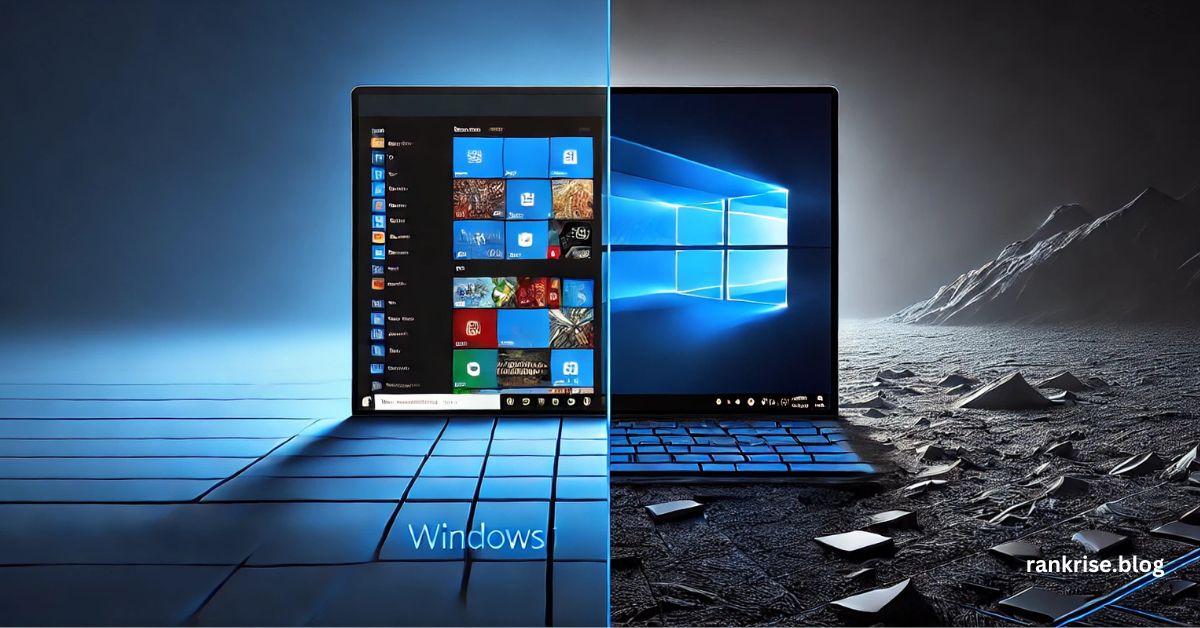Windows 11 is the latest operating system from Microsoft, replacing Windows 10 with a fresh design and enhanced performance. With its modern interface, improved security, and advanced multitasking features, Windows 11 aims to offer a more seamless experience. However, Windows 10 remains a popular choice for users who prefer stability, compatibility with older software, and flexibility in customization.
Many users are wondering: Is upgrading to Windows 11 worth it, or should I stick with Windows 10? In this in-depth comparison, we’ll explore the differences between Windows 10 vs Windows, including system requirements, user interface changes, performance, gaming features, security enhancements, and software compatibility. By the end of this article, you’ll have a clear understanding of which operating system suits your needs the best.
User Interface and Design
Windows 11 comes with a completely redesigned user interface. The Start menu is now centered, creating a more modern and sleek look. Icons have rounded corners, and the overall design feels inspired by macOS. Windows 10, on the other hand, maintains a more traditional look, with a left-aligned taskbar and sharper window edges.
While Windows 11 offers a visually appealing experience, users who prefer familiarity may find Windows 10 easier to use. Additionally, Windows 11 removes the ability to move the taskbar, which has frustrated some users. If you love customization, Windows 10 is the better choice.
System Requirements
Before deciding which Windows version to use, it’s essential to check if your device meets the system requirements. Windows 11 has stricter hardware requirements, which may prevent some older PCs from upgrading. Below are the official system requirements for both Windows 10 vs Windows:
| Feature | Windows 10 | Windows 11 |
|---|---|---|
| Processor | 1 GHz, 32-bit or 64-bit | 1 GHz, 64-bit, 2+ cores, must be on Microsoft’s supported list |
| RAM | 1GB (32-bit), 2GB (64-bit) | 4GB minimum |
| Storage | 16GB (32-bit), 20GB (64-bit) | 64GB minimum |
| Graphics | DirectX 9 compatible with WDDM 1.0 driver | DirectX 12 compatible with WDDM 2.0 driver |
| Display | 800 x 600 resolution | 720p HD resolution or higher |
| TPM (Trusted Platform Module) | Not required | TPM 2.0 required |
| Secure Boot | Optional | Required |
If your PC does not meet Windows 11’s hardware requirements, Windows 10 remains the best option as it is compatible with older systems and will receive updates until October 14, 2025.
Performance and Requirements
Microsoft claims that Windows 11 improves performance by optimizing memory management and background processes. It also wakes up from sleep mode faster, thanks to better power efficiency. However, Windows 11 has strict hardware requirements that prevent older PCs from upgrading.
Windows 11 requires a TPM 2.0 security chip, Secure Boot, and a processor from Intel 8th Gen or AMD Ryzen 2000 series and newer. If your system doesn’t meet these requirements, Windows 10 remains your best option. Windows 10 runs smoothly on older hardware and still receives regular updates until October 14, 2025.
Gaming Features and Performance
For gamers, Windows 11 offers Auto HDR, which improves colors and lighting in games without requiring any changes to settings. It also includes DirectStorage, allowing faster load times by reducing CPU usage when accessing game files. Additionally, the Xbox Game Pass app is better integrated into Windows 11, making it easier to access cloud gaming.
Windows 10 is still a solid choice for gaming, especially for those using older PCs. It supports DirectX 12, and most games run just as well as they do on Windows 11. However, if you own a high-end gaming PC, Windows 11 provides better optimization and future-proof features.
Multitasking and Productivity Improvements
Windows 11 introduces Snap Layouts and Snap Groups, making multitasking more efficient. You can quickly organize multiple windows on your screen, a significant improvement for professionals working with multiple apps. Windows 11 also remembers your window layout when using multiple monitors, which is great for productivity.
Windows 10 has traditional window snapping, but it lacks the advanced layouts of Windows 11. If you frequently switch between multiple apps, Windows 11 enhances your workflow. However, if you’re comfortable with basic multitasking, Windows 10 is still a reliable option.
Software and App Compatibility
One major difference between the two operating systems is software support. Windows 10 supports most legacy applications, making it ideal for users who rely on older software. Many businesses and organizations continue using Windows 10 because of its stability and compatibility.
Windows 11, however, introduces Android app support via the Microsoft Store, allowing users to install mobile apps on their PC. While this is a great feature, Windows 11 is still relatively new, meaning some older applications may not work as smoothly as they do on Windows 10.
Security and Updates of Windows 10 vs Windows
Security is a major focus of Windows 11. The new OS requires TPM 2.0, which provides hardware-based encryption to improve security against malware and ransomware attacks. Windows 11 also receives security updates more frequently than Windows 10.
Windows 10 is still secure but will only receive updates until 2025. If you want long-term security updates, upgrading to Windows 11 is the better choice. However, if you have antivirus software and follow safe browsing habits, Windows 10 remains a viable option.
Side-by-Side Comparison Windows 10 vs Windows
| Feature | Windows 10 | Windows 11 |
|---|---|---|
| Start Menu | Left-aligned | Centered |
| Taskbar Customization | More flexible | Restricted (cannot move taskbar) |
| Performance | Stable and optimized | Faster wake-up times and improved efficiency |
| System Requirements | Runs on older devices | Requires TPM 2.0, Secure Boot, and newer processors |
| Gaming Features | DirectX 12 | DirectX 12, Auto HDR, DirectStorage |
| Multitasking | Basic snapping | Snap Layouts, Snap Groups, better multi-monitor support |
| Security | Regular updates until 2025 | Stronger security with TPM 2.0 and frequent updates |
| Software Compatibility | Supports older apps | Android app support but stricter requirements |
Conclusion: Windows 10 vs Windows?
Choosing between Windows 10 vs Windows 11 depends on your needs and hardware. If your PC meets the system requirements, Windows 11 is a future-proof option with a modern design, better gaming features, and enhanced security. However, if you have an older device or rely on legacy software, Windows 10 remains a stable and reliable choice until its end-of-support date in 2025.
For gamers and professionals, Windows 11’s new features offer noticeable improvements. But for users who prioritize stability, familiarity, and customization, Windows 10 still holds strong. Ultimately, Windows 10 vs Windows 11 comes down to personal preference, hardware compatibility, and performance needs.
Frequently Asked Questions (FAQs)
Can I still use Windows 10 after 2025?
Yes, but Microsoft will stop providing security updates, making your system vulnerable to threats.
How do I check if my PC supports Windows 11?
Use Microsoft’s PC Health Check tool to check compatibility.
Is Windows 11 free to upgrade from Windows 10?
Yes, Windows 11 is a free upgrade for eligible Windows 10 users.
Can I downgrade back to Windows 10 from Windows 11?
Yes, but only within 10 days of upgrading without losing your files.
Does Windows 11 improve gaming performance?
Yes, with Auto HDR, DirectStorage, and better resource management.
Will my old apps work on Windows 11?
Most will, but some older apps may face compatibility issues.
Windows 10 vs Windows 11 both have their strengths. Choose based on your needs, and make the most of your Windows experience!
“Windows 10 vs Windows 11Windows 10 vs Windows 11Windows 10 vs Windows 11Windows 10 vs Windows 11Windows 10 vs Windows 11”



